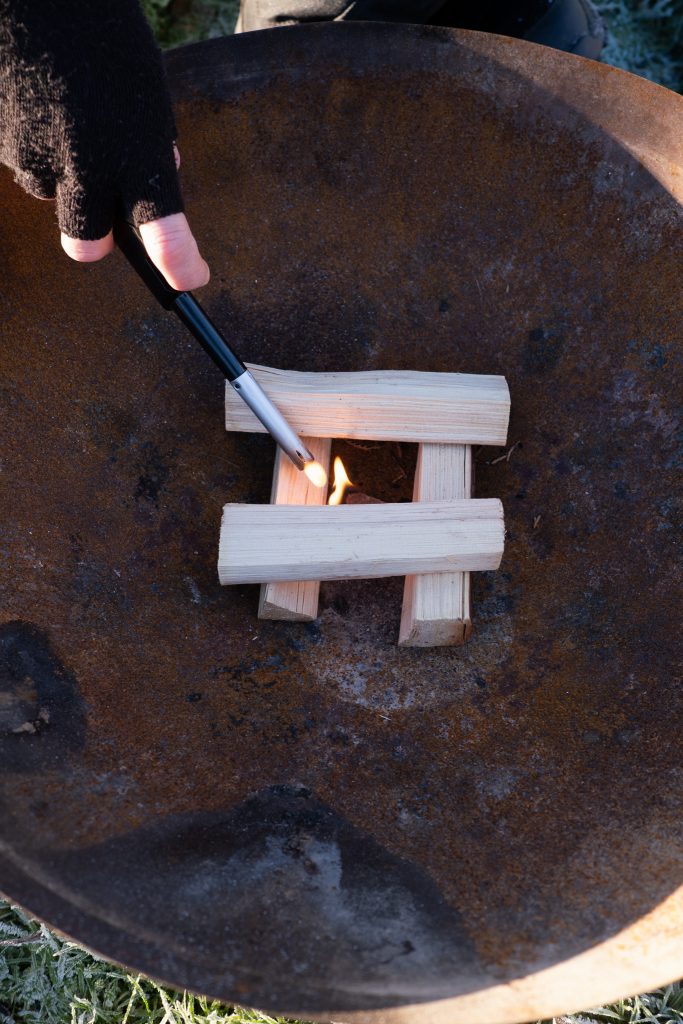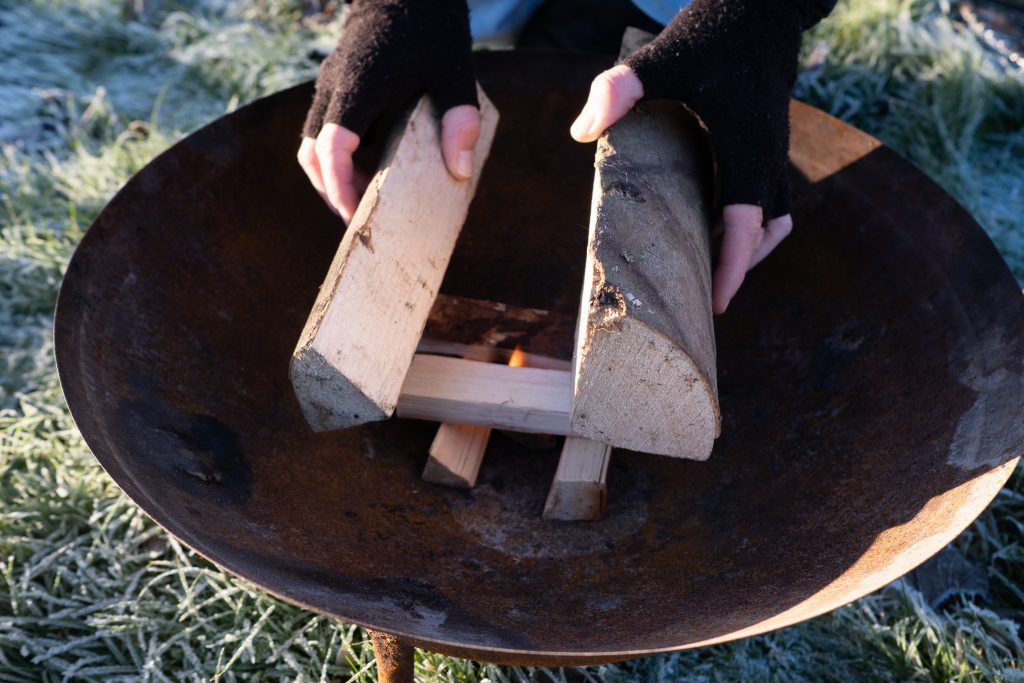Beginner’s guide on how to cook over a campfire and campfire cooking tips for nights outside
Food consumed outside always tastes that much better and there’s something even more satisfying about cooking over a campfire. It adds a depth of flavour to your evening nom and it’s pretty fun.
But cooking over a fire is a lot different to a hob or oven at home. You don’t have the same control over the heat and at-home recipes may not work as well outside.
This beginner’s guide with tips on how to cook over a fire will cover what you need to know, from the different cooking options and what recipes work best. To help you feel confident cooking over flames and tuck into some delicious campfire grub.

Using a Stove or Pit to Make Your Fire
You can use a few different options for making a fire to cook on. The first is a wood-burning stove that allows you to burn wood as the fuel source. These usually will enable you to burn a small amount of wood for anywhere between 1-4 people, depending on the size of your stove.
We use the Bushbox XL as our wood-burning stove and we love it. It keeps the fire off the ground and can be packed easily for multi-day trips.
Alternatively, you can use a fire pit to build your fire. These are usually a lot bigger in comparison to stoves, so you can cook multiple pots at one time or grill larger items like skewers. Due to their size and weight, they are however not the most convenient. A better option for car camping trips, when you can carry the extra weight.
The other method is to build your own fire pit. You can do this in the ground, then build your fire from there. This option allows you to build a fire where you camp and also means you have to carry very little with you if you’re moving from place to place. Except maybe a lighter and firelighter, which are both very small.

How to Build a Fire
In order to build a fire to cook on there are a few things you’ll need to consider first:
- Location – Firstly check that it’s safe to make a fire. If it’s the peak of a drought and you’re surrounded by dried wood, best not to start a roaring fire. Some protected areas don’t allow fires and some places in summer, may not allow fires due to the high risk of wildfires. If you’re making your own pit, try to use a spot someone has used before to reduce damage to the local environment. Consider where the wind is coming from when building your fire to maximise the heat and minimise any hazards.
- Clearance – Once you know it’s safe and you’re allowed, make sure your fire is at least 10ft away from any structure, like your tent. You also want to ensure there are no low-hanging trees or debris overhead that could catch alight.
- Wood – Your fuel source for your dinner, so it’s important to use the right wood for your fire. You need to burn wood that is seasoned and dry. Wet wood won’t burn well and will create a lot of smoke which is bad to inhale and honestly just pretty annoying. You’ll need small bits of wood to act as kindling as you get the fire burning, then a big supply of larger logs to burn as you cook. You may not want to add all your logs at once as you’ll need to keep the free burning as you cook. This will depend on whether you’re making one dish or continuing to cook as the fire burns.
- Building a fire pit – If you’re cooking in a raised fire pit or one you’ve dug build your fire by:
- Placing your kindling piece by piece vertically. Anywhere from 3 pieces will do depending on their size and the size of your firepit.
- Then place more kindling on top in a horizontal pattern creating a cross-hatch pattern. You can stop here or add another layer if the kindling you’re using is small.
- Next place firelighter or rolled-up bits of newspaper in the gaps in the centre of the cross-hatch pattern. Then light it.
- Once the kindling starts to catch, add your wood. As the flames die down you will be left with white coals which are ideal for cooking on. This can take up to 45 minutes, so patience is key.
- Place large stones or rocks around the outside of your fire to create a pit to contain the fire and minimise hazards.
- Top tip: if you’re placing a grill on top of your fire, make sure your pieces of wood are roughly the same size so the grill balances evenly and they burn at about the same time.


If you’re after more ethical outdoor guides and plant-based adventure food, sign up for our newsletter to get our latest posts
How to Cook On a Campfire
In order to cook up some tasty grub you’ll need a surface or pot to cook your food on. This will depend on the type of trip you’re on, how much you can carry and what food you’re making.
Cooking With a Pot or Pan on a Fire
If you’re cooking with a pot or pan, you will need something to hold the pot above the fire. Camping pots and pans can either be made from cast iron, which is hard-wearing and heavy. Or for lighter weight options, they can be made with steel or aluminium.
For this type of cooking, you want the pot to be held above the fire. Pots made of steel and aluminium aren’t as hard-wearing, so could be damaged if they come into too close contact with the heat.
For smaller wood-burning stoves, they are usually designed to balance a pot on top. Then for a bigger fire pit, you can use a grill to place above the flames and hold your pot. Or you can use a cooking tripod to hang the pot above your fire.
Cooking over a fire with a pot is good for one-pot meals such as curries or pasta dishes. You can focus on one pot which makes the whole process a lot simpler. It means you can have a smaller heat source and therefore need less wood to burn.
Using a pan on an open fire is better for frying things like pancakes, burgers or french toast.
For this method of cooking the heat will be coming from underneath and you don’t have the same control as you would on a hob at home. This means the heat can often be quite high. In order to stop food burning you’ll find you need to use a lot more oil than usual. You’ll also need to be turning and stirring food more frequently to ensure it cooks evenly.

Cooking With a Dutch Oven
Dutch oven cooking is a little different as your pot will be surrounded by hot coals. This method is better for meals like campfire lasagne or a crumble.
If you’re using a dutch oven, you need to get your fire going about 45 minutes beforehand, to allow the coals to get really hot. Once they’re hot enough, place your dutch oven on top of some of the coals. Then place some more coals on top and around the pot so the food cooks thoroughly from all sides.
This method is a slower way of cooking and dutch ovens are usually made from cast iron, which means they’re heavy. Making it a better option for car camping when you can carry the extra weight. You’ll need bigger logs to burn and generate enough heat for your dutch oven.

Cooking on a Grill
Cooking straight onto the grill is also an option when cooking on a fire. Things like sausages and skewers are great on the grill. Just avoid overly fatty foods, as the fat dripping into the fire may spark too many flames.
Small wood-burning stoves sometimes have a built-in grill or grill attachment for cooking on. These can often be small, however, and maybe only big enough to grill one burger at a time. Therefore not ideal if there are a lot of hungry mouths to feed.
For cooking on a larger fire pit with a grill, you have the option to go a lot bigger. You can make multiple portions at once and accommodate bigger items too. Things like veggies and tofu marinaded, then wrapped in foil are delicious when placed on top of the grill to cook.
Top tip: you can add foods wrapped in foil to the fire whilst the flames are still big, before the logs form white coals. The foil will protect them from burning and speed up the cooking process.
If you want to expand your outside cooking skills further, check out our 13 tasty and useful camping cooking tips to help make preparing meals outside a breeze.

Keep exploring…
15 Hacks for Pimping Your Vegan Adventure Food on the Campfire
The Ultimate Guide to Vegan Camping Food
10 Best Plant-Based Protein Foods for Camping
All of Our Vegan Adventure Food Guides & Tips for Making Meals Outside
What Do You Need to Cook on a Fire
As well as your surface for cooking on there are a few other bits that are important for campfire cooking:
- Handle – if your pot doesn’t have a handle built-in, you will need a detachable one. Just be sure not to leave it on the pot whilst it’s cooking as it’ll heat up quickly and easily burn your fingers.
- Spoon or spatula – whether you’re flipping burgers or stirring the pot, you need a utensil so your food doesn’t stick and cooks evenly.
- Glove or teatowel – pots can get hot and something to protect your hand will help massively.
- Oil – no matter what you’re making, cooking over an open fire can get really hot. So a lot of oil will stop any food from sticking and burning.
- Long-nose lighter – to help you light your fire and avoid burnt fingertips.
- Natural firelighter – not essential but natural firelighters are super useful to get a fire going easily and they avoid burning any nasty chemicals.
- Knife – essential for camping cooking.
- Chopping board – less essential but incredibly useful if you do a lot of campfire cooking.





